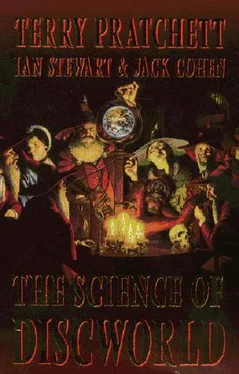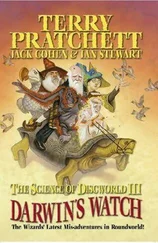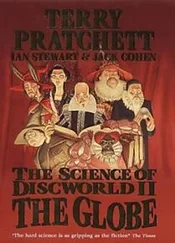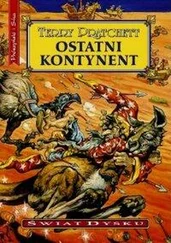Terry Pratchett - Science of Discworld
Здесь есть возможность читать онлайн «Terry Pratchett - Science of Discworld» весь текст электронной книги совершенно бесплатно (целиком полную версию без сокращений). В некоторых случаях можно слушать аудио, скачать через торрент в формате fb2 и присутствует краткое содержание. Жанр: Фантастика и фэнтези, на английском языке. Описание произведения, (предисловие) а так же отзывы посетителей доступны на портале библиотеки ЛибКат.
- Название:Science of Discworld
- Автор:
- Жанр:
- Год:неизвестен
- ISBN:нет данных
- Рейтинг книги:4 / 5. Голосов: 1
-
Избранное:Добавить в избранное
- Отзывы:
-
Ваша оценка:
- 80
- 1
- 2
- 3
- 4
- 5
Science of Discworld: краткое содержание, описание и аннотация
Предлагаем к чтению аннотацию, описание, краткое содержание или предисловие (зависит от того, что написал сам автор книги «Science of Discworld»). Если вы не нашли необходимую информацию о книге — напишите в комментариях, мы постараемся отыскать её.
Science of Discworld — читать онлайн бесплатно полную книгу (весь текст) целиком
Ниже представлен текст книги, разбитый по страницам. Система сохранения места последней прочитанной страницы, позволяет с удобством читать онлайн бесплатно книгу «Science of Discworld», без необходимости каждый раз заново искать на чём Вы остановились. Поставьте закладку, и сможете в любой момент перейти на страницу, на которой закончили чтение.
Интервал:
Закладка:
It is interesting to note that back in the Cretaceous, when the seas were a lot warmer than now, these hot plumes could even have risen to the ocean's surface, where they may have caused 'hyper-canes', like hurricanes but with a windspeed close to that of sound. These would have caused major climatic upheavals on a planet which, as we shall see, it not the moderately peaceful place we tend to believe it is.
Bacteria belong to the grade of organisms known as prokaryotes. They are often said to be 'single-celled', but many single-celled creatures are far more complex and very different from bacteria. Bacteria are not true cells, but something simpler; they have no cell wall and no nucleus. True cells, and creatures both single-celled and many-celled, came later, and are called eukaryotes. They probably arose when several different prokaryotes joined forces to their mutual benefit, a trick known as symbiosis. The first fossil eukaryotes are singe-celled, like amoebas, and appear about 2 billion years ago. The first fossils of many-celled creatures are algae from 1 billion years ago ... maybe even as old as 1.8 billion years.
This was the story as scientists understood it up until 1998: animals like arthropods and other complex beasts came into being a mere 600 million years ago, and that until about 540 million years ago the only creatures were very strange indeed, quite unlike most of what's around today.
These creatures are known as Ediacarans, after a place in Australia where the first fossils were found. They could grow to half a metre or more, but as far as can be told from the fossil record, seem not to have had any internal organs or external orifices like a mouth or an anus (they may have survived by digesting symbiotic bacteria in their selves, or by some other process we can only guess at). Some were flattened, and clustered together in quilts. We have no idea whether the Ediacarans were our distant ancestors, or whether they were a dead end, a lifestyle doomed to failure. No matter: they were around then, and as far as anyone knew, not much else was. There are hints of fossil wormcasts, though, and some very recent fossils look like ... but we're getting ahead of the story. The point is that nearly all Ediacaran life was apparently unrelated to what came later.
About 540 million years ago the Pre-Cambrian Ediacarans were succeeded by the creatures of the Cambrian era. For the first ten million years, these beasties were also pretty weird, leaving behind fragments of spines and spikes which presumably are the remains of prototype skeletons that hadn't yet joined up. At that point, nature suddenly learned how to do joined-up skeletons, and much else: this was the time known as the Cambrian Explosion. Twenty million years later virtually every body-plan found in modern animals was already in existence: everything afterwards was mere tinkering. The real innovation of the Cambrian Explosion, though, was less obvious than joined-up skeletons or tusks or shells or limbs. It was a new kind of body plan. Diploblasts were overtaken by triploblasts ...
Sorry, Archchancellor. We mean that creatures began to put another layer between themselves and the universe. Ediacarans and modern jellyfish are diploblasts, two-layered creatures. They have an inside and an outside, like a thick paper bag. Three-layered creatures like us and practically everything else around are called triploblasts. We have an inner, an outer, and a within.
The within was the big leap forward, or at least the big slither. Within you can put the things you need to protect, like internal organs. In one sense, you are not part of the environment any more, there is a you as well. And, like someone who now has a piece of property of their very own, you can begin to make improvements. This is a lie-to-children, but as lies go it is a good one. Triploblasts played a crucial role in evolution, precisely because they did have internal organs, and in particular they could ingest food and excrete it. Their excreta became a major resource for other creatures; to get an interestingly complicated world, it is vitally important that shit happens.
But where did all those triploblasts come from? Were they an offshoot of the Ediacarans? Or did they come from something else that didn't leave fossils?
It's hard to see how they could have come from Ediacarans. Yes, an extra layer of tissue might have appeared, but as well as that extra layer you need a lot of organization to exploit it. That organization has to come from somewhere. Moreover, there were these occasional tantalizing traces of what might have been pre-Cambrian triploblasts, fossils not of worms, which would have clinched it, but of things that might have been trails made by worms in wet mud.
And then again, might not.
In February 1998, we found out.
The discovery depended upon where, and in this case how -you look for fossils. One way for fossils to form is by petrification. There is a poorly known type of petrification that can happen very fast, within a few days. The soft parts of a dead organism are replaced by calcium phosphate. Unfortunately for palaeontologists, this process works only for organisms that are about a tenth of an inch (2 mm) long. Still, some interesting things are that tiny. From about 1975 onwards scientists found wonderfully preserved specimens of tiny ancient arthropods, creatures like centipedes with many segments. In 1994 they found fossilized balls of cells from embryos, early stages in the development of an organism, and it is thought that these come from embryonic triploblasts. However, all of these creatures must have come after the Ediacarans. But in 1998 Shuhai Xiao, Yun Zhang, and Andrew Knoll discovered fossilized embryos in Chinese rock that is 570 million years old -smack in the middle of the Ediacaran era. And those embryos were triploblasts.
Forty million years before the Cambrian explosion, there were triploblasts on Earth, living right alongside those enigmatic Ediacarans.
We are triploblasts. Somewhere in the pre-Cambrian, surrounded by mouthless, organless Ediacarans, we came into our inheritance.
It used to be thought that life was a delicate, highly unusual phenomenon: difficult to create, easy to destroy. But everywhere we look on Earth we find living creatures, often in environments that we would have expected to be impossibly hostile. It's beginning to look as if life is an extremely robust phenomenon, liable to turn up almost anywhere that's remotely suitable. What is it about life that makes it so persistent?
Earlier we talked about two ways to get off the Earth, a rocket and a space elevator. A rocket is a thing that gets used up, but a space elevator is a process that continues. A space elevator requires a huge initial investment, but once you've got it, going up and down is essentially free. A functioning space elevator seems to contradict all the usual rules of economics, which look at individual transactions and try to set a rational price, instead of asking whether the concept of a price might be eliminated altogether. It also seems to contradict the law of conservation of energy, the physicist's way of saying that you can't get something for nothing. But, as we've seen, you can, by exploiting the new resources that become available once you get your space elevator up and running.
There is an analogy between space elevators and life. Life seems to contradict the usual rules of chemistry and physics, especially the rule known as the second law of thermodynamics, which says that things can't spontaneously get more complicated. Life does this because, like the space elevator, it has lifted itself to a new level of operation, where it can gain access to things and processes that were previously out of the question. Reproduction, in particular, is a wonderful method of getting round the difficulties of manufacturing a really complicated thing. Just build one that manufactures more of itself. The first one may be incredibly difficult, but all the rest come with no added effort.
Читать дальшеИнтервал:
Закладка:
Похожие книги на «Science of Discworld»
Представляем Вашему вниманию похожие книги на «Science of Discworld» списком для выбора. Мы отобрали схожую по названию и смыслу литературу в надежде предоставить читателям больше вариантов отыскать новые, интересные, ещё непрочитанные произведения.
Обсуждение, отзывы о книге «Science of Discworld» и просто собственные мнения читателей. Оставьте ваши комментарии, напишите, что Вы думаете о произведении, его смысле или главных героях. Укажите что конкретно понравилось, а что нет, и почему Вы так считаете.












